Bibliometric and Visual Analysis of Studies on Ceramic Membranes: A Review
Abstract
1. Introduction
2. Retrieval Method
2.1. Retrieval Strategy
(AB = membrane AND TS = (Perovskite OR ceramic OR aluminum oxide OR alumina OR corundum OR zirconia OR zirconium oxide OR zirconium dioxide OR zincite OR titania OR titanium oxide OR titanium dioxide OR silica OR silicon oxide OR yttria OR yttrium oxide OR hafnia OR hafnium oxide OR ferric oxide OR iron oxide OR aluminum nitride OR boron nitride OR boramon OR silicon nitride OR carborundum OR silicon carbide OR carbofuran OR nicalon OR titanium carbide OR mullite OR cordierite OR silicon OR kaolin OR bentonite OR bauxite OR attapulgite OR portland OR apatite OR quartz OR flay ash OR clay OR Al2O3 OR TiO2 OR ZrO2 OR SiO2 OR Y2O3 OR HfO2 OR Fe2O3 OR AlN OR BN OR Si3N4 OR SiC OR TiC OR MXene))
- (1)
- Upon reviewing the initial results, certain terms such as cell membrane, Nafion, membrane proteins, biomembrane, and proton exchange membrane were identified as significant sources of interference. These terms have consequently been excluded to improve the specificity of the search.
- (2)
- An analysis of the search outcomes also revealed the inclusion of literature from unrelated subject categories, such as virology, surgery, and zoology. These categories have been systematically excluded through the subject category classification feature provided by Web of Science (WOS).
2.2. Evaluation and Analysis Methods
3. Result and Discussion
3.1. Evaluation of Retrieval Strategy
3.2. The Spatial and Temporal Distribution of the Literature
- (1)
- The initial period (1990–1999) is indicated in the yellow part, marks the nascent stage of development. Beginning in the late 1980s, the National Natural Science Foundation of China launched projects focused on inorganic membrane research. This initiative spurred major scientific institutions such as the Chinese Academy of Sciences, the University of Science and Technology of China, and Nanjing Tech University to commence their related research efforts.
- (2)
- The second period (2000–2014) indicated in the green part, saw a consistent increase in publications. This era of rapid development and industrialization of ceramic membrane technology can be attributed to robust national science and technology projects and the burgeoning membrane separation market in China. Nanjing Tech University pioneered the mass production of tubular ceramic membranes domestically. During this time, significant advancements were made in ceramic membrane research, spanning from theoretical foundations to practical applications.
- (3)
- The current phase, (2014 to the present) indicated by the blue part, is characterized by stabilization. This could be due to two primary factors: the trend towards internationalization, with researchers favoring publications in international journals, and a shift driven by national policies on scientific and technological achievement conversion and market forces, leading some researchers to focus on industrialization, with the outcomes of the research being published in patents and other forms [33,34]. This has resulted in a slowed growth trend in academic publications. From 2014 to 2022, the annual publication rate stabilized at around 170 papers.
3.3. Distribution of the Literature Based on the Source of Publication
3.4. Analysis of Author Cooperation
3.5. Research Hot Spots
3.6. High-Impact Publications
4. Conclusions
- (1)
- A retrieval strategy and a formula for ceramic membrane literature were established, yielding approximately 15,250 refined articles. The retrieval approach was assessed on recall and precision rates, achieving 84.20% and 74.33%, respectively, laying a solid foundation for further bibliometric and visual analysis.
- (2)
- An examination of the literature distribution across geographical, temporal, and thematic dimensions reveals that the research on ceramic membranes has reached a stage of maturity. Significantly, the contributions from China, the USA, Germany, and Japan are predominant in this field, with China alone contributing over half of the total publications by 2022. The top ten journals collectively constitute 29.81% of the publications, reflecting a concentrated yet varied landscape of research primarily situated within the domains of Chemical Engineering and Water Resources.
- (3)
- The employment of visual analytics tools like VOSviewer and CiteSpace has facilitated the delineation of author co-occurrence networks and the clustering of keywords. This analysis has revealed a tightly knit core group of authors and has uncovered the long-tail effect within the realm of ceramic membrane applications. This long tail signifies a spectrum of numerous potential research areas and emerging topics within ceramic membranes that are ripe for further exploration and practical application.
- (4)
- CiteSpace’s burst detection feature has uncovered the key literature on porous ceramic membranes that corresponds with significant periods of development in this research field. Burst activity, beginning around 1995 and becoming more pronounced around 2011, indicates a shift in research dynamics. Initial studies were primarily focused on membrane process design, material development, and fundamental properties. More recent research, however, has pivoted towards optimizing cost-efficiency and enhancing the performance of membranes within specific applications, indicating a trend toward practical implementation and industry-oriented solutions.
Supplementary Materials
Author Contributions
Funding
Institutional Review Board Statement
Data Availability Statement
Conflicts of Interest
References
- Mao, X.; Wang, Y.; Yan, X.; Huang, Z.; Gao, Z.; Wang, Y.; Huang, L.; Kipper, M.J.; Tang, J. A review of superwetting membranes and nanofibers for efficient oil/water separation. J. Mater. Sci. 2023, 58, 3–33. [Google Scholar] [CrossRef]
- Chrisma, R.B.; Jafri, R.I.; Anila, E.I. A review on the electrochemical behavior of graphene–transition metal oxide nanocomposites for energy storage applications. J. Mater. Sci. 2023, 58, 6124–6150. [Google Scholar] [CrossRef]
- Sazali, N. A review of the application of carbon-based membranes to hydrogen separation. J. Mater. Sci. 2020, 55, 11052–11070. [Google Scholar] [CrossRef]
- Elimelech, M.; Phillip, W.A. The future of seawater desalination: Energy, technology, and the environment. Science 2011, 333, 712–717. [Google Scholar] [CrossRef] [PubMed]
- Guliants, V.V.; Carreon, M.A.; Lin, Y.S. Ordered mesoporous and macroporous inorganic films and membranes. J. Membr. Sci. 2004, 235, 53–72. [Google Scholar] [CrossRef]
- Ovalle-Encinia, O.; Lin, J.Y.S. Synthesis and characteristics of porous ceramic tubes: A comparison of centrifugal casting and cold isostatic pressing methods. J. Mater. Sci. 2023, 58, 10261–10273. [Google Scholar] [CrossRef]
- Asif, M.B.; Zhang, Z.H. Ceramic membrane technology for water and wastewater treatment: A critical review of performance, full-scale applications, membrane fouling and prospects. Chem. Eng. J. 2021, 418, 129481. [Google Scholar] [CrossRef]
- Gao, N.; Fan, Y.; Quan, X.; Cai, Y.; Zhou, D. Modified ceramic membranes for low fouling separation of water-in-oil emulsions. J. Mater. Sci. 2016, 51, 6379–6388. [Google Scholar] [CrossRef]
- Samaei, S.M.; Gato-Trinidad, S.; Altaee, A. The application of pressure-driven ceramic membrane technology for the treatment of industrial wastewaters—A review. Sep. Purif. Technol. 2018, 200, 198–220. [Google Scholar] [CrossRef]
- Das, B.; Chakrabarty, B.; Barkakati, P. Preparation and characterization of novel ceramic membranes for micro-filtration applications. Ceram. Int. 2016, 42, 14326–14333. [Google Scholar] [CrossRef]
- Wang, H.; Cai, Z.; Li, S.; Zheng, J.; Xie, Y.; He, Y.; Li, C.; Zheng, D. Research hotspots and frontiers of post-stroke aphasia rehabilitation: A bibliometric study and visualization analysis. Front. Hum. Neurosci. 2023, 17, 1176923. [Google Scholar] [CrossRef] [PubMed]
- Xue, J.; Han, R.; Li, Y.; Zhang, J.; Liu, J.; Yang, Y. Advances in multiple reinforcement strategies and applications for silica aerogel. J. Mater. Sci. 2023, 58, 14255–14283. [Google Scholar] [CrossRef]
- Klavans, R.; Boyack, K.W. Identifying a better measure of relatedness for mapping science. J. Am. Soc. Inf. Sci. Technol. 2006, 57, 251–263. [Google Scholar] [CrossRef]
- Zhang, L.; Zhong, Y.; Geng, Y. A bibliometric and visual study on urban mining. J. Clean. Prod. 2019, 239, 118067. [Google Scholar] [CrossRef]
- Ellegaard, O. The application of bibliometric analysis: Disciplinary and user aspects. Scientometrics 2018, 116, 181–202. [Google Scholar] [CrossRef]
- Ferreira, J.J.M.; Ferreira, F.A.F.; Fernandes, C.I.M.A.S.; Jalali, M.S.; Raposo, M.L.; Marques, C.S. What do we not know about technology entrepreneurship research? Int. Entrep. Manag. J. 2016, 12, 713–733. [Google Scholar] [CrossRef]
- Ang, W.L.; Mohammad, A.W.; Johnson, D.; Hilal, N. Forward osmosis research trends in desalination and wastewater treatment: A review of research trends over the past decade. J. Water Process Eng. 2019, 31, 100886. [Google Scholar] [CrossRef]
- Escobar Yonoff, R.; Ochoa, G.V.; Cardenas-Escorcia, Y.; Ivan Silva-Ortega, J.; Merino-Stand, L. Research trends in proton exchange membrane fuel cells during 2008-2018: A bibliometric analysis. Heliyon 2019, 5, e01724. [Google Scholar] [CrossRef] [PubMed]
- Wang, C.-C.; Ho, Y.-S. Research trend of metal-organic frameworks: A bibliometric analysis. Scientometrics 2016, 109, 481–513. [Google Scholar] [CrossRef]
- Naseer, M.N.; Dutta, K.; Zaidi, A.A.; Asif, M.; Alqahtany, A.; Aldossary, N.A.; Jamil, R.; Alyami, S.H.; Jaafar, J. Research trends in the use of polyaniline membrane for water treatment applications: A scientometric analysis. Membranes 2022, 12, 777. [Google Scholar] [CrossRef]
- Miranda, D.M.V.d.; Dutra, L.d.S.; Way, D.; Amaral, N.; Wegenast, F.; Scaldaferri, M.C.; Jesus, N.; Pinto, J.C. A bibliometric survey of paraffin/olefin separation using membranes. Membranes 2019, 9, 157. [Google Scholar] [CrossRef] [PubMed]
- Aytaç, E.; Khayet, M. A topic modeling approach to discover the global and local subjects in membrane distillation separation process. Separations 2023, 10, 482. [Google Scholar] [CrossRef]
- Li, W.; Dong, H.; Yu, H.; Wang, D.; Yu, H. Global characteristics and trends of research on ceramic membranes from 1998 to 2016: Based on bibliometric analysis combined with information visualization analysis. Ceram. Int. 2018, 44, 6926–6934. [Google Scholar] [CrossRef]
- Kwok, K.L. A network approach to probabilistic information-retrieval. ACM Trans. Inf. Syst. 1995, 13, 324–353. [Google Scholar] [CrossRef]
- Ye, C.; Sun, H.-J.; Xu, Q.; Liang, T.; Zhang, Y.; Liu, Q. Working memory capacity affects trade-off between quality and quantity only when stimulus exposure duration is sufficient: Evidence for the two-phase model. Sci. Rep. 2019, 9, 8727. [Google Scholar] [CrossRef] [PubMed]
- Chen, C.M.; Hu, Z.G.; Liu, S.B.; Tseng, H. Emerging trends in regenerative medicine: A scientometric analysis in CiteSpace. Expert Opin. Biol. Ther. 2012, 12, 593–608. [Google Scholar] [CrossRef] [PubMed]
- Gehanno, J.F.; Thaon, I.; Pelissier, C.; Rollin, L. Precision and recall of search strategies for identifying studies on work-related psychosocial risk factors in PubMed. J. Occup. Rehabil. 2023, 33, 776–784. [Google Scholar] [CrossRef] [PubMed]
- Ding, X.; Yang, Z. Knowledge mapping of platform research: A visual analysis using VOSviewer and CiteSpace. Electron. Commer. Res. 2022, 22, 787–809. [Google Scholar] [CrossRef]
- Chen, C.M. CiteSpace II: Detecting and visualizing emerging trends and transient patterns in scientific literature. J. Am. Soc. Inf. Sci. Technol. 2006, 57, 359–377. [Google Scholar] [CrossRef]
- van Eck, N.J.; Waltman, L. Software survey: VOSviewer, a computer program for bibliometric mapping. Scientometrics 2010, 84, 523–538. [Google Scholar] [CrossRef]
- Woolston, C. Scientists count the career costs of COVID. Nature 2021, 599, 331–334. [Google Scholar] [CrossRef]
- Mongeon, P.; Paul-Hus, A. The journal coverage of Web of Science and Scopus: A comparative analysis. Scientometrics 2016, 106, 213–228. [Google Scholar] [CrossRef]
- Wang, Y.F.; Yan, C.G.; Xiao, Z.H.; Luo, X.N. Technological Innovation Trend of Ceramic Membranes: A Study Based on the Patent Information Analysis. J. Ceram. 2020, 41, 429–435. (In Chinese) [Google Scholar] [CrossRef]
- Feng, J.; Ke, W.; Qiu, H. Research on the development of waste oil treatment using membrane separation technology from the perspective of patent. Membr. Sci. Technol. 2021, 41, 155–164. (In Chinese) [Google Scholar] [CrossRef]
- Shneider, A.M. Four stages of a scientific discipline; four types of scientist. Trends Biochem. Sci. 2009, 34, 217–223. [Google Scholar] [CrossRef]
- Zaviska, F.; Drogui, P.; Grasmick, A.; Azais, A.; Héran, M. Nanofiltration membrane bioreactor for removing pharmaceutical compounds. J. Membr. Sci. 2013, 429, 121–129. [Google Scholar] [CrossRef]
- George, S.M.; Kandasubramanian, B. Advancements in MXene-Polymer composites for various biomedical applications. Ceram. Int. 2020, 46, 8522–8535. [Google Scholar] [CrossRef]
- Zhang, D.; Kanezashi, M.; Tsuru, T.; Yamamoto, K.; Gunji, T.; Adachi, Y.; Ohshita, J. Preparation of thermally stable 3-glycidyloxypropyl-POSS-derived polysilsesquioxane RO membranes for water desalination. J. Membr. Sci. 2023, 668, 7. [Google Scholar] [CrossRef]
- Moriyama, N.; Nagasawa, H.; Kanezashi, M.; Tsuru, T. Water permeation in gas and liquid phases through organosilica membranes: A unified theory of reverse osmosis, pervaporation, and vapor permeation. Chem. Eng. Sci. 2022, 263, 14. [Google Scholar] [CrossRef]
- Fan, H.W.; Wang, H.R.; Peng, M.H.; Meng, H.; Mundstock, A.; Knebel, A.; Caro, J. Pore-in-Pore Engineering in a Covalent Organic Framework Membrane for Gas Separation. ACS Nano 2023, 17, 7584–7594. [Google Scholar] [CrossRef]
- Li, Z.K.; Liu, Y.C.; Li, L.B.; Wei, Y.Y.; Caro, J.; Wang, H.H. Ultra-thin titanium carbide (MXene) sheet membranes for high-efficient oil/water emulsions separation. J. Membr. Sci. 2019, 592, 8. [Google Scholar] [CrossRef]
- Chen, P.; Ma, X.; Zhong, Z.; Zhang, F.; Xing, W.; Fan, Y. Performance of ceramic nanofiltration membrane for desalination of dye solutions containing NaCl and Na2SO4. Desalination 2017, 404, 102–111. [Google Scholar] [CrossRef]
- Wei, W.; Zhang, W.; Jiang, Q.; Xu, P.; Zhong, Z.; Zhang, F.; Xing, W. Preparation of non-oxide SiC membrane for gas purification by spray coating. J. Membr. Sci. 2017, 540, 381–390. [Google Scholar] [CrossRef]
- Yang, Y.; Xu, W.; Zhang, F.; Low, Z.-X.; Zhong, Z.; Xing, W. Preparation of highly stable porous SiC membrane supports with enhanced air purification performance by recycling NaA zeolite residue. J. Membr. Sci. 2017, 541, 500–509. [Google Scholar] [CrossRef]
- Hei, Y.P.; Wu, S.; Lu, Z.J.; Meng, X.; Song, J.; Yang, N.; Meng, B.; Li, C.; Sunarso, J.; Kawi, S.; et al. Dual-phase Ce0.8Sm0.2O2−δ-La0.8Ca0.2Al0.3Fe0.7O3−δ oxygen permeation hollow fiber membrane for oxy-CO2 reforming of methane. Catal. Sci. Technol. 2024, 14, 2275–2285. [Google Scholar] [CrossRef]
- Chen, G.X.; Widenmeyer, M.; Yu, X.; Han, N.; Tan, X.Y.; Homm, G.; Liu, S.M.; Weidenkaff, A. Perspectives on achievements and challenges of oxygen transport dual-functional membrane reactors. J. Am. Ceram. Soc. 2024, 107, 1490–1504. [Google Scholar] [CrossRef]
- Ruocco, G.; Daraio, C.; Folli, V.; Folli, V. Bibliometric indicators: The origin of their log-normal distribution and why they are not a reliable proxy for an individual scholar’s talent. Palgrave Commun. 2017, 3, 17064. [Google Scholar] [CrossRef]
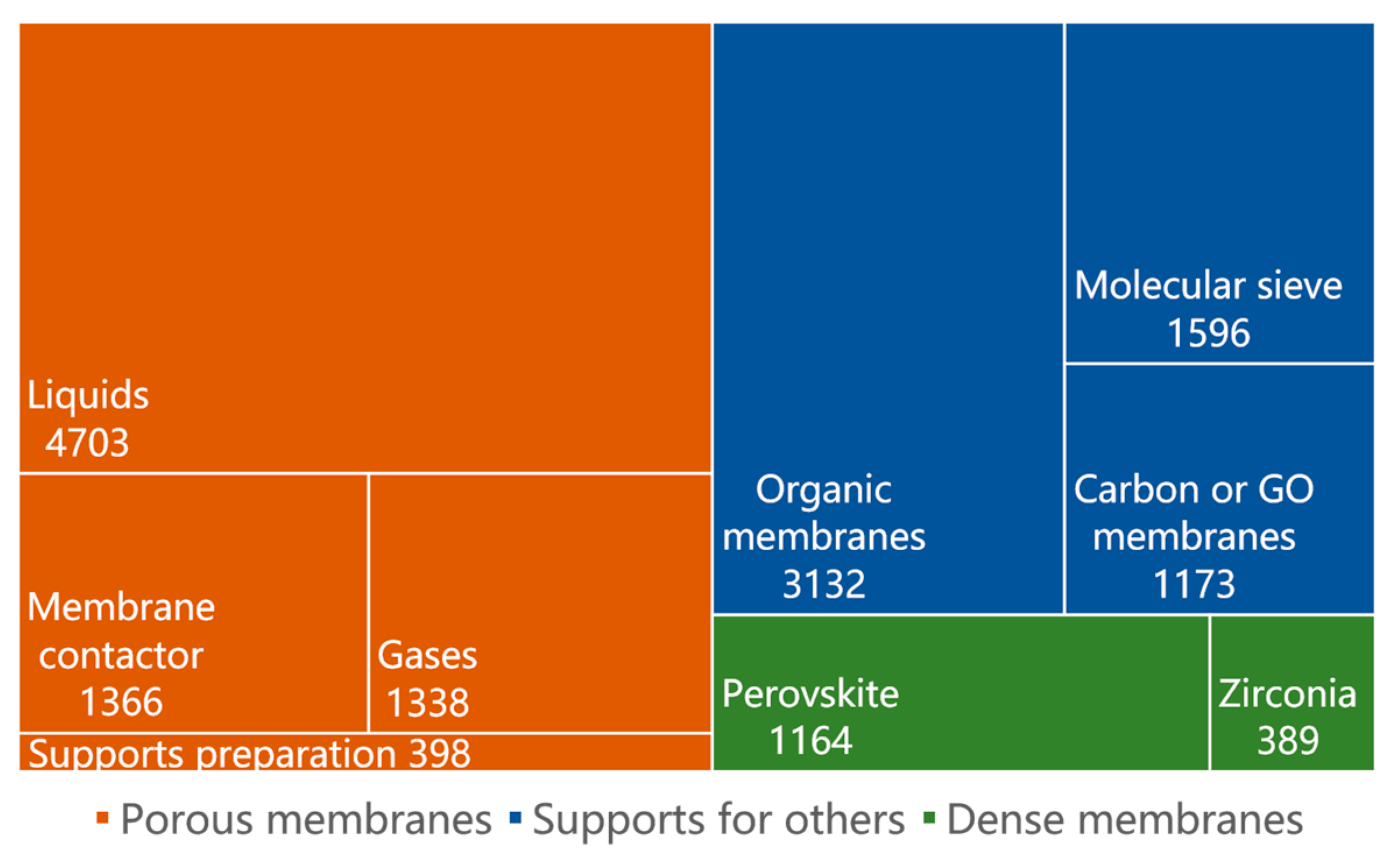

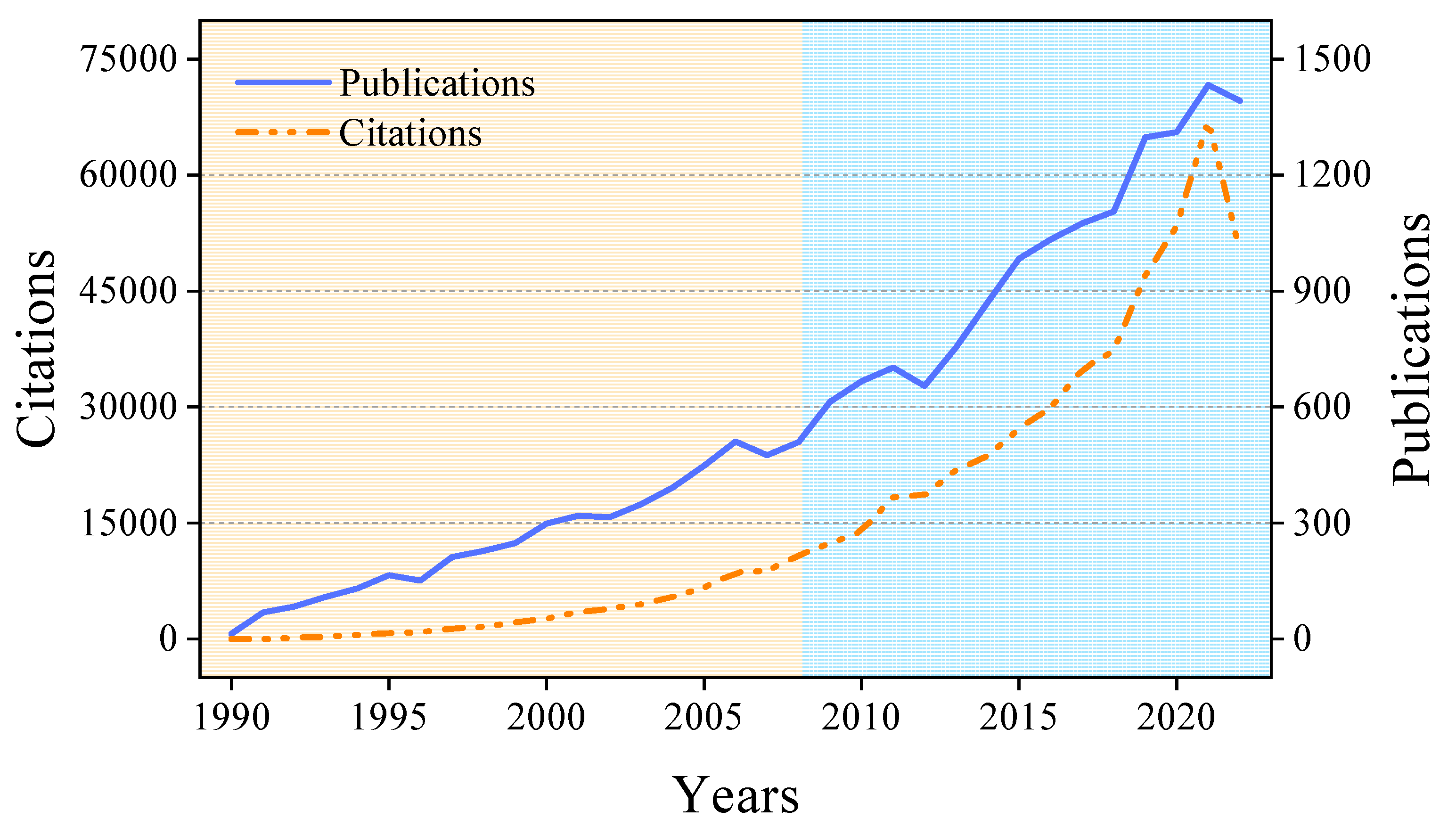
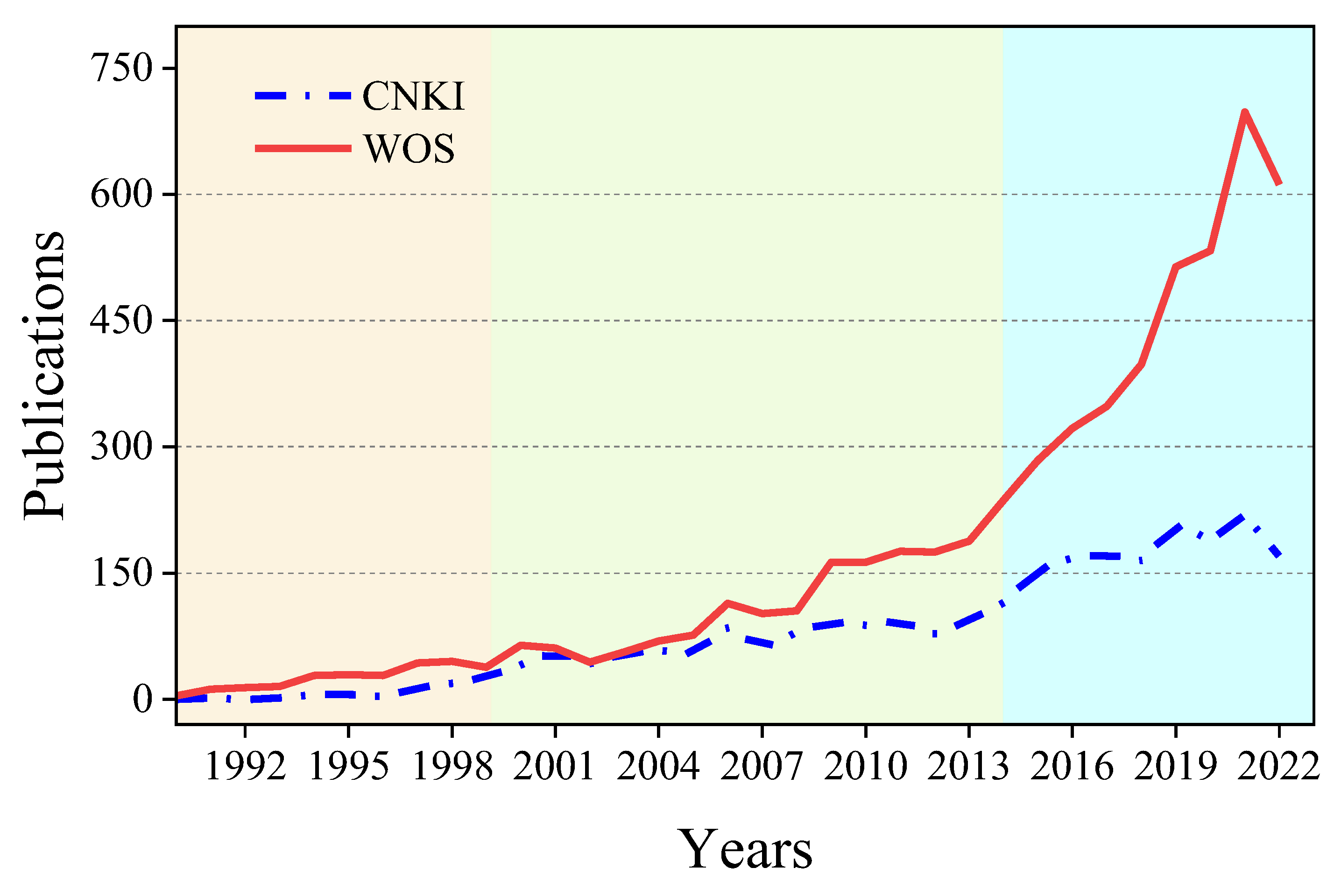


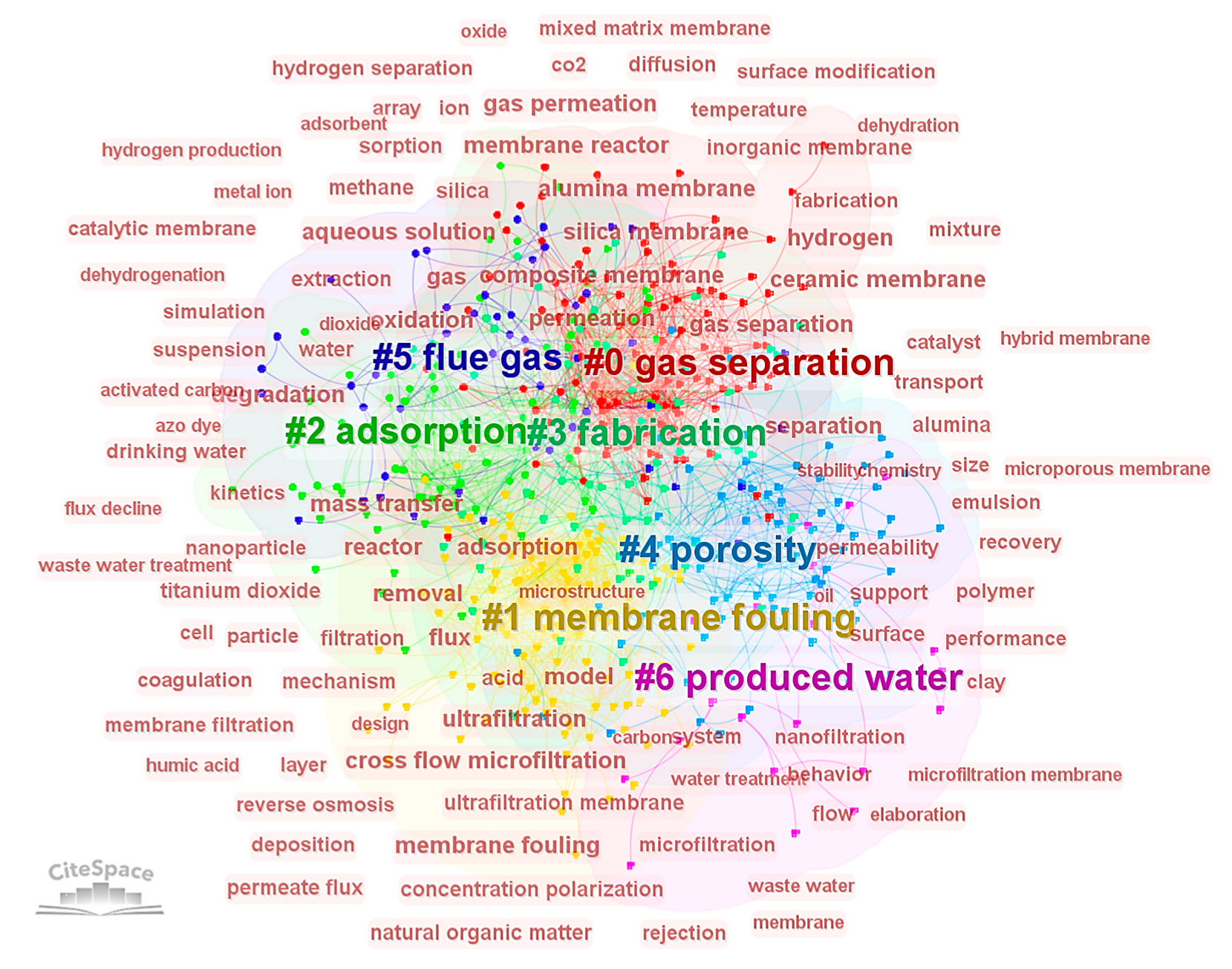
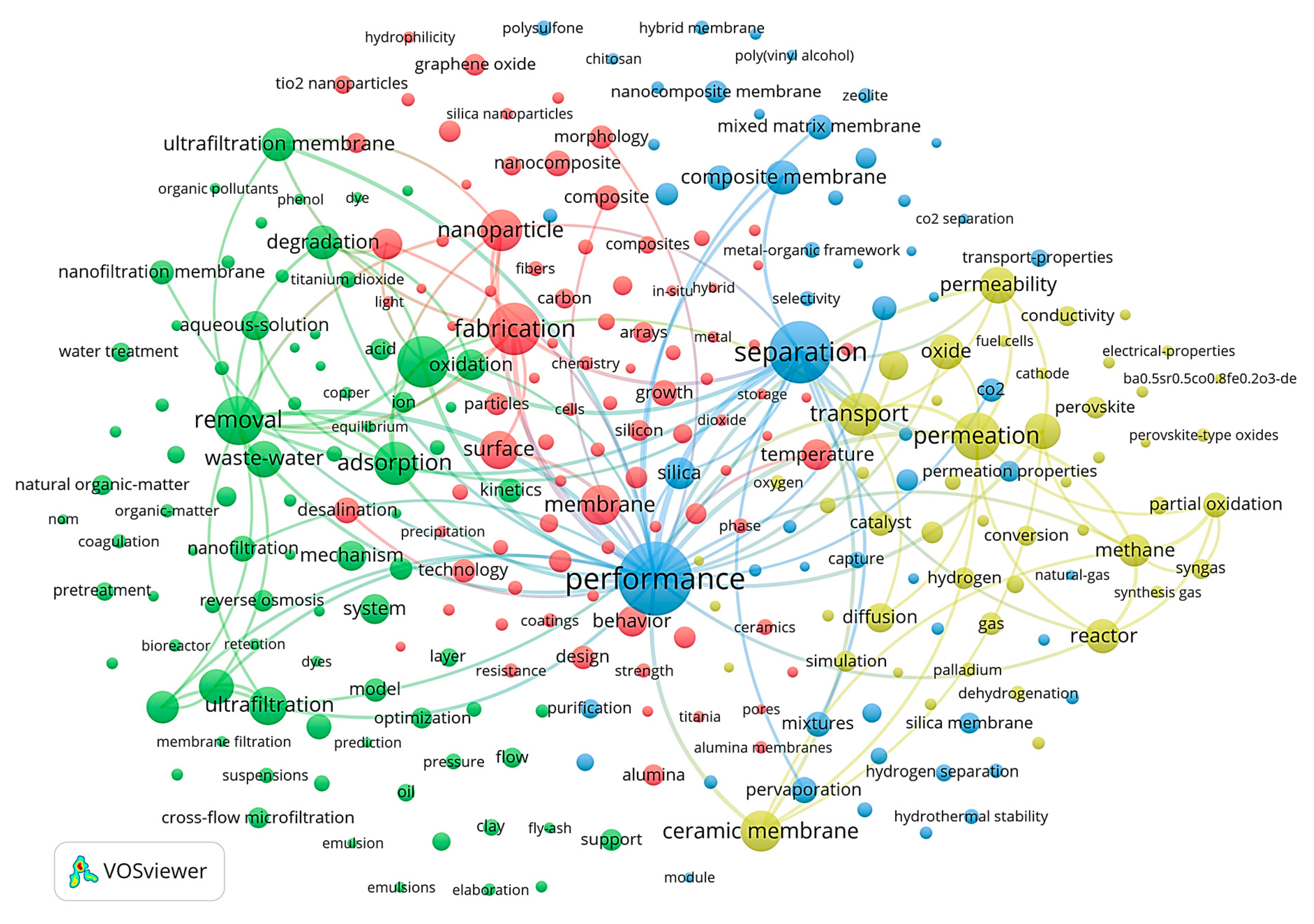
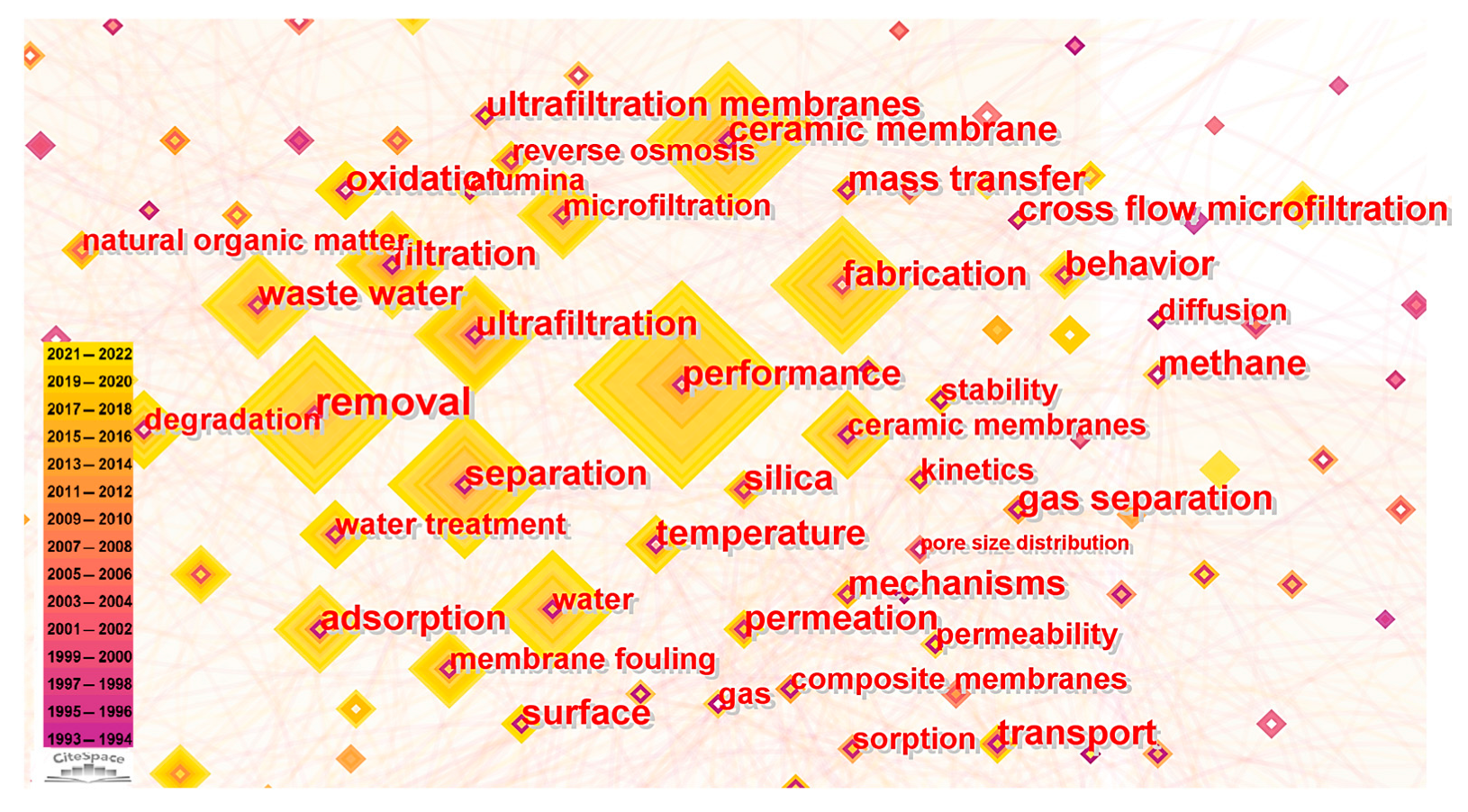

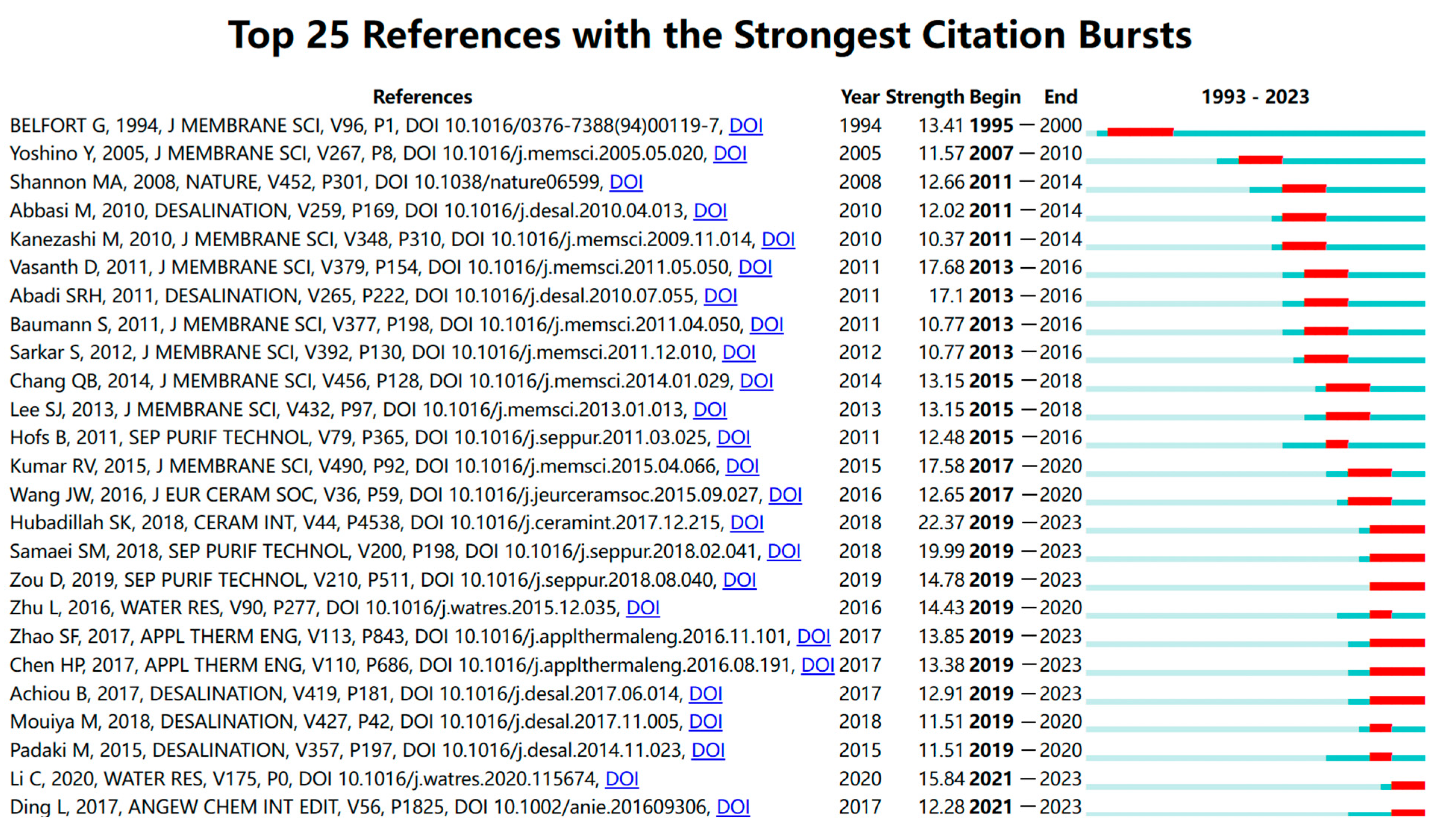
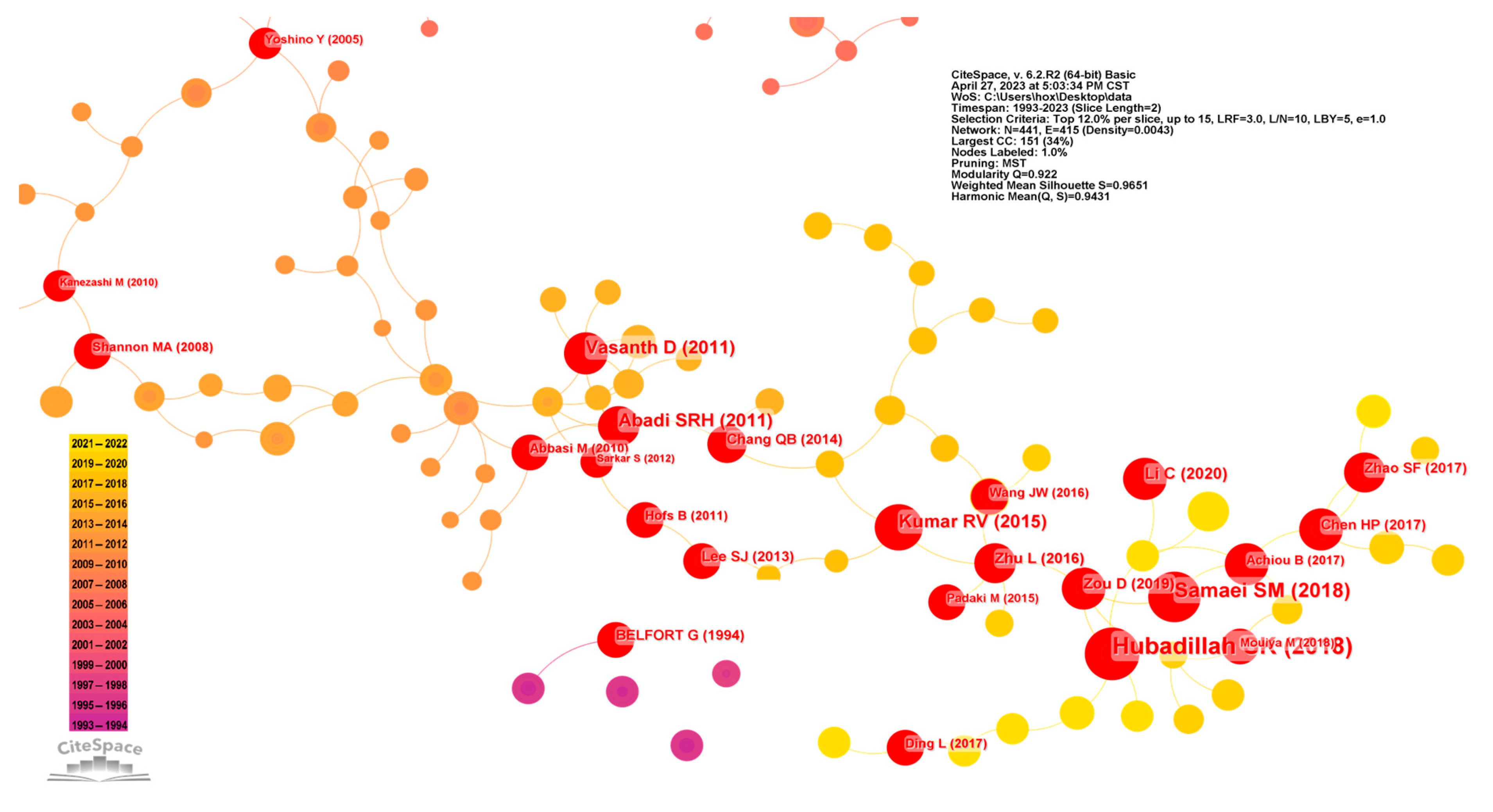
| Institutions | NP | NA |
|---|---|---|
| Chinese Academy of Sciences | 930 | 1107 |
| Centre National de la Recherche Scientifique (CNRS) | 623 | 745 |
| Nanjing Tech University | 530 | 561 |
| UDICE-French Research Universities | 300 | 424 |
| Helmholtz Association | 260 | 302 |
| Total | 2643 | 3139 |
| Years | Publications | Citations | Ratio/% |
|---|---|---|---|
| 1992 | 84 | 139 | 1.65 |
| 1996 | 151 | 896 | 5.75 |
| 2000 | 299 | 2626 | 8.78 |
| 2004 | 391 | 5446 | 13.93 |
| 2008 | 510 | 10,843 | 21.26 |
| 2012 | 655 | 18,621 | 28.43 |
| 2016 | 1033 | 29,973 | 29.02 |
| 2020 | 1311 | 53,455 | 40.77 |
| Years | Publications from CNKI | Patents from China | Projects from NSFC |
|---|---|---|---|
| 1990 | 0 | 1 | 1 |
| 1991 | 1 | 2 | 1 |
| 1992 | 0 | 1 | 3 |
| 1993 | 1 | 0 | 4 |
| 1994 | 6 | 2 | 1 |
| 1995 | 6 | 4 | 8 |
| 1996 | 3 | 5 | 2 |
| 1997 | 14 | 11 | 2 |
| 1998 | 19 | 7 | 2 |
| 1999 | 26 | 13 | 4 |
| 2000 | 41 | 19 | 2 |
| 2001 | 58 | 27 | 5 |
| 2002 | 42 | 25 | 5 |
| 2003 | 55 | 36 | 2 |
| 2004 | 58 | 50 | 9 |
| 2005 | 53 | 74 | 9 |
| 2006 | 86 | 111 | 8 |
| 2007 | 58 | 116 | 10 |
| 2008 | 80 | 188 | 8 |
| 2009 | 93 | 221 | 16 |
| 2010 | 88 | 228 | 16 |
| 2011 | 95 | 328 | 18 |
| 2012 | 77 | 449 | 20 |
| 2013 | 94 | 516 | 19 |
| 2014 | 115 | 634 | 23 |
| 2015 | 155 | 874 | 27 |
| 2016 | 168 | 989 | 20 |
| 2017 | 173 | 1191 | 21 |
| 2018 | 174 | 1543 | 20 |
| 2019 | 210 | 1605 | |
| 2020 | 189 | 1664 | |
| 2021 | 219 | 1968 | |
| 2022 | 170 | 1899 |
| Rank | Journals | Publications | Categories |
|---|---|---|---|
| 1 | Journal of Membrane Science | 2021 | Engineering, Chemical Polymer Science |
| 2 | Separation and Purification Technology | 808 | Engineering, Chemical |
| 3 | Desalination | 637 | Engineering, Chemical Water Resources |
| 4 | Desalination and Water treatment | 389 | Engineering, Chemical Water Resources |
| 5 | Industrial Engineering Chemistry Research | 351 | Engineering, Chemical |
| 6 | Chemical Engineering Journal | 390 | Engineering, Chemical Engineering, Environmental |
| 7 | Ceramics International | 270 | Materials Science, Ceramics |
| 8 | International Journal of Hydrogen Energy | 257 | Chemistry, Physical Electrochemistry Energy and Fuels |
| 9 | RSC Advances | 227 | Chemistry, Multidisciplinary Chemistry, Physical Materials Science, Multidisciplinary |
| 10 | ACS Applied Materials Interfaces | 207 | Materials Science, Multidisciplinary Nanoscience and Nanotechnology |
Disclaimer/Publisher’s Note: The statements, opinions and data contained in all publications are solely those of the individual author(s) and contributor(s) and not of MDPI and/or the editor(s). MDPI and/or the editor(s) disclaim responsibility for any injury to people or property resulting from any ideas, methods, instructions or products referred to in the content. |
© 2024 by the authors. Licensee MDPI, Basel, Switzerland. This article is an open access article distributed under the terms and conditions of the Creative Commons Attribution (CC BY) license (https://creativecommons.org/licenses/by/4.0/).
Share and Cite
Xiong, H.; Chen, X.; Feng, J.; Zhang, F.; Qiu, M.; Zhang, Q.; Fan, Y. Bibliometric and Visual Analysis of Studies on Ceramic Membranes: A Review. Membranes 2024, 14, 144. https://doi.org/10.3390/membranes14070144
Xiong H, Chen X, Feng J, Zhang F, Qiu M, Zhang Q, Fan Y. Bibliometric and Visual Analysis of Studies on Ceramic Membranes: A Review. Membranes. 2024; 14(7):144. https://doi.org/10.3390/membranes14070144
Chicago/Turabian StyleXiong, Hao, Xianfu Chen, Jun Feng, Fan Zhang, Minghui Qiu, Qi Zhang, and Yiqun Fan. 2024. "Bibliometric and Visual Analysis of Studies on Ceramic Membranes: A Review" Membranes 14, no. 7: 144. https://doi.org/10.3390/membranes14070144
APA StyleXiong, H., Chen, X., Feng, J., Zhang, F., Qiu, M., Zhang, Q., & Fan, Y. (2024). Bibliometric and Visual Analysis of Studies on Ceramic Membranes: A Review. Membranes, 14(7), 144. https://doi.org/10.3390/membranes14070144





